|
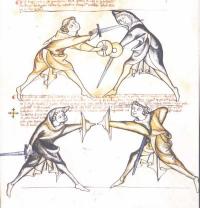
|
¶
Prius quam superius in tertio exemplo ymaginarum fixura quedam ducta est
per scolarem eandem vero fixuram sacerdos hic defendit recipiendo
schilslac
schiltslac ut patet hic per exemplum
(+)
¶
Hic iterum
se
resumitur quinta custodia de qua superius dictum est sepius & est notandum
quod sacerdos obsedit scolarem obsessione quandam rara & valde bona in
exemplum suorum discipulorum & sciatur quod si scolaris ducet fixuram que
duci consueuit de consuetudine sacerdos debet etiam ducere fixuram contra
fixuram scolaris quia sua magis valet intrando cum sinistro pede si autem
intrare nequiuerit cedat cum dextro pede nichillominus non obmittatur quin
etiam ipsa fixura perficiatur si autem scolaris obsedit eum econtrario
mediante halpscilt sacerdos cadet sub gladio & scutum & tunc superueniunt
ea que prius visa sunt in custodia prima Vnde versus
Dum ducitur halpscilt cade sub gladium quoque scutum
|
First, as above in the third example of the pictures, the same stab
is executed by the pupil, and this stab is deflected by the priest,
by means of a schiltslac, as shown here in the example
(+)
Here the fifth ward is again resumed, of which much was said above, and it
is to be noted that the priest is displacing the pupil with a displacement
that is rare and very good, as an example for his students. And you have
to know, that if the pupil executes a stab, which to execute is usually
the use, the priest also must execute a stab against the stab of the
pupil, because his will be more effective, entering with the left foot.
But if he does not want to enter he should nevertheless retract his right
foot and not omit this stab. But if the pupil displaces against him by
means of halpscilt, the priest should fall below sword and shield,
and then will follow those things which were seen before. Thence the
verse, when halpscilt is assumed, fall below sword and shield.
|
 Notes on this presentation
Notes on this presentation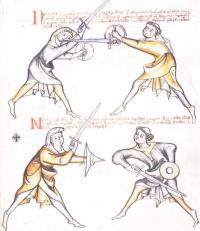
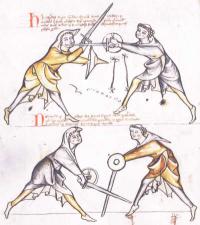
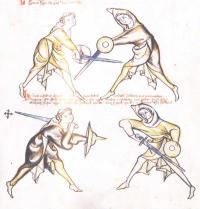
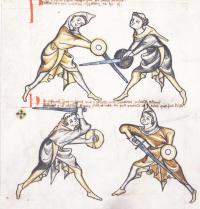
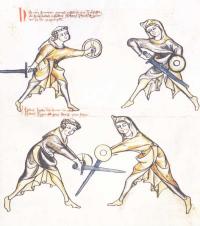
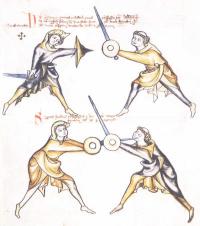
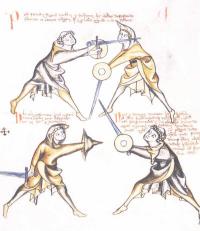
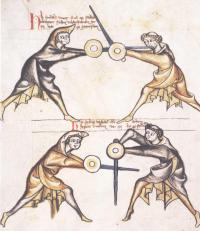

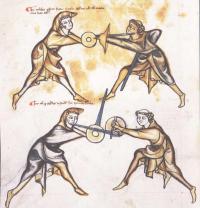
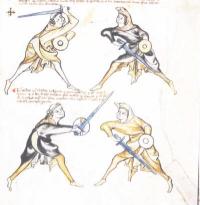
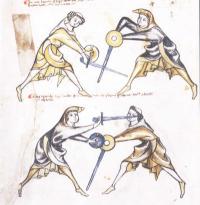
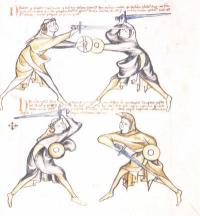
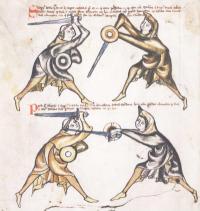
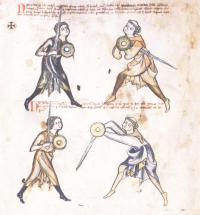
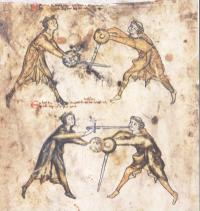
 Concerning the name of the woman fencer: The name walprgis as written directly above the word sac'dos (below which are five dots forming a line). It is not entirely clear, whether Walpurgis is meant to replace sacerdos or if it is an addition (in which case it would be genitive of Walpurga). But since in the picture, the woman is executing the schiltslac, and because the woman is said to have been ready first (parata), she must be called (in the nominative) Walpurgis.
Concerning the name of the woman fencer: The name walprgis as written directly above the word sac'dos (below which are five dots forming a line). It is not entirely clear, whether Walpurgis is meant to replace sacerdos or if it is an addition (in which case it would be genitive of Walpurga). But since in the picture, the woman is executing the schiltslac, and because the woman is said to have been ready first (parata), she must be called (in the nominative) Walpurgis.